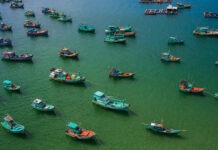Now a modest player on the world stage, Cambodia was once the seat of one of Asia’s most magnificent early civilizations, the mighty Khmer empire of Angkor, whose legendary temples continue to provide a touchstone of national identity, as well as attracting millions of visitors every year. Away from the temples, much of the country remains refreshingly tourist-free and, in many places, largely unexplored.

Phnom Penh: Cambodia’s capital is the frenetic heartbeat of the nation; a city of chaotic streets abuzz with motorbikes and car horns that can frazzle at first glance. For visitors, this is Cambodia’s most cosmopolitan destination, with a café and restaurant scene unrivaled in the rest of the country. It is also home to a scattering of important historic sites that help unravel both Cambodia’s modern and ancient history.

Battambang: The countryside of rice fields and tiny villages surrounding the northwest city of Battambang holds some of the most tranquil rural scenery in Cambodia, and the area is home to swags of historic riches as well. All of this has made the city itself a popular destination on traveler itineraries. For history fans, the temples of Phnom Sampeau, Phnom Banan, and Wat Ek Phnom are all within day-tripping distance, while the famed Bamboo – a single-line rail track where ‘carriages’ made from a platform of wood and bamboo travel between Battambang’s east bank and the tiny village of O Srav – is one of the most popular activities for visitors.

Kampot: The laidback riverine town of Kampot has oodles of old world ambience. The compact central district is a joy to ramble around; full of surviving shop-house architecture, some of which has been painstakingly restored. Kampot’s charm lies in its exceedingly chilled out atmosphere, and many travelers find themselves waylaid here longer than they expected, having succumbed to its easygoing pace.

Ratanakiri: This is outback Cambodia and the endless red-dirt roads of the region, leading to ethnic minority villages, are an intrepid traveler’s delight. For those with an adventurous streak, the province is home to some of Cambodia’s best trekking, from spotting gibbons at Veun Sai-Siem Pang Conservation Area, where overnight trips involve sleeping in hammocks and early rises to track buff-cheeked gibbons, to hiking in Virachey National Park, home to elephants, tigers, and sun bears. There is more relaxing options on offer as well. The emerald water of Yeak Lom Crater Lake just outside of Ban Lung town is a tranquil swimming spot, while the waterfalls of Chaa Ong and Ka Tieng are fun diversions that provide more opportunities for getting wet. Ratanakiri is a nature-filled reprieve for travelers suffering from temple-fatigue.

Koh Rong Samloem: Just off Cambodia’s south coast lie a scattering of islands just as beautiful as their Thai counterparts to the west, but much less visited. Compared to the now very developed islands of Koh Samui and Phuket, Cambodia’s islands are a slice of laidback tropical bliss, where sun and sand take center stage, and the big resorts have yet to make their mark. Of all the islands, Koh Rong Samloem is one of the most beautiful with the long, sandy Saracen Bay home to a dozen beach hut resorts that offer a welcome respite from the world. It is really all about hammock-time here, but there is plenty of scuba diving activities on offer for the more active.

Tonlé Sap Lake: Tonlé Sap is Cambodia’s most important waterway and Southeast Asia’s largest freshwater lake. As well as being an important source of food and a vital tool for Cambodian irrigation, the lake itself is home to 170 floating villages that depend on fishing for their livelihood, with homes built directly on the water. The houses, shops, churches, schools, and temples of these villages are built on rustic buoy foundations of lashed together barrels and bamboo, and all transport is by boat.

Kratie: If you are here for the full Mekong experience, you have come to the right place. Spread along the banks of the mighty Mekong, Kratie has become a major destination for travelers due to its dolphin-watching tours. The endangered Irrawaddy dolphins are endemic to the Mekong, and environmental measures have now been put in place to try and help their dwindling numbers. Tourism has played a good role in trying to protect the dolphins by offering an alternative economy to fishing. To see the dolphins head to Kampi, just north of Kratie, where there are plenty of boat tours available.

Sihanoukville Beaches: In Kompong Som Province, Sihanoukville is a tale of two halves, with a bustling but drab central district and its shoreline area home to a vibrant beach resort. The beaches here are Cambodia’s top destination for sand and sun holidays and are popular with both local and foreign tourists. There is something for every kind of beach-goer here. Sokha Beach and Independence Beach boast the luxury hotels. Brash Ochheuteal Beach and the Serendipity Beach area are the most popular sandy strips and in recent years have emerged as one of Southeast Asia’s backpacker party areas. For a much quieter scene, just to the south is Otres Beach with beach huts huddled directly on the sand, a sprinkling of classy boutique hotels, and a number of up-and-coming restaurants.

Angkor Wat: This temple city is Cambodia’s number one drawcard. Accessed from the town of Siem Reap, the temples of the Angkorian period are so ambitious in scale and in the majesty of their construction, that Angkor Wat is rated as one of the world’s must-see ancient sites. Built between AD 802 and 1432, this was the largest city in the world during the medieval age and the vast powerhouse of the Khmer kings who endeavored to outbid their predecessors in the beauty of their construction. As the city’s wooden dwellings were encroached and then decayed by the surrounding jungle, what remains today, are just those mighty temples.

Prasat Preah Vihear: The temples of Angkor Wat may gain all the glory, but Prasat Preah Vihear wins the prize for the most dramatic location. Sitting atop the Dangrek Mountains, on an escarpment with dizzying views across the Cambodian floodplains, Prasat Preah Vihear is a monumental temple complex of intricately carved pavilions linked by long causeways, built originally to honor the god Shiva. The temple is snug against the border with Thailand and has historically been a point of contention between the two nations, who both claim it as their own. The International Court of Justice ruled in Cambodia’s favor in 2013, which led to border disputes flaring up between 2008 and 2011. Tensions have dissipated in the last few years, meaning this UNESCO World Heritage Site can now reclaim its rightful role on the tourist trail.

Sambor Prei Kuk: This pre-Angkorian temple site dates from the early 7th century when it was the capital of the Upper Chenla Empire. More than 100 brick temples dedicated to various Hindu gods sit within the forest here, many half-swallowed by mammoth tree roots. Archaeologically, the site is extremely important, containing some of Cambodia’s oldest surviving buildings, but you do not have to be an archaeology buff to appreciate the ethereal beauty of this tree-wrapped site. The most important temples in the area are found in Prasat Sambor, Prasat Tao, and Prasat Yeay Peau, which all have remarkably clear carvings on their temple walls and plenty of ethereal ambience provided by twisting tree trunks and coiling vines.

















